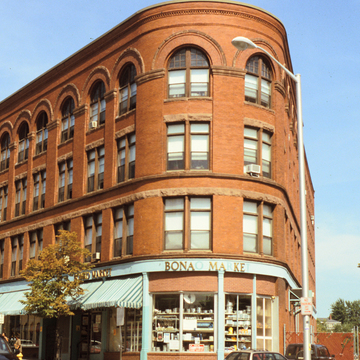In November 1889, a fire destroyed much of the Lynn central business district. The late-nineteenth-century prosperity of this industrial city, however, ensured that the district would be rebuilt quickly. A number of the large multistory buildings erected for offices and light industry are the work of three of Lynn's most important turn-of-the-century architects: Henry W. Rogers, Edwin Earp, and Penn Varney. Most were built immediately after the fire and are variations of Italian Renaissance or Richardsonian Romanesque architecture. The work of Henry Rogers includes 125–155 Munroe Street (1890), 101–127 Munroe Street (1891), and the unusual Romanesque-style flatiron-shaped Fabens Building at 312–332 Union Street (1890). Edwin Earp designed the six-story Mowers Block in 1891 (7 Willow Street), as well as the structure at 1–21 Central Square (1890). Penn Varney added the block at 50–56 Central Square in 1890. This densely built-up commercial district is bounded on the south by the Boston & Maine Railroad viaduct (1913).
You are here
Central Square Historic District
If SAH Archipedia has been useful to you, please consider supporting it.
SAH Archipedia tells the story of the United States through its buildings, landscapes, and cities. This freely available resource empowers the public with authoritative knowledge that deepens their understanding and appreciation of the built environment. But the Society of Architectural Historians, which created SAH Archipedia with University of Virginia Press, needs your support to maintain the high-caliber research, writing, photography, cartography, editing, design, and programming that make SAH Archipedia a trusted online resource available to all who value the history of place, heritage tourism, and learning.


